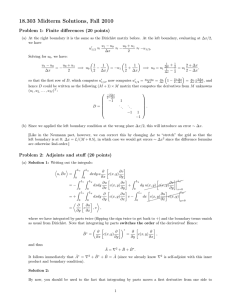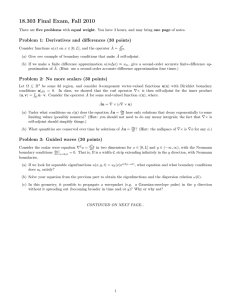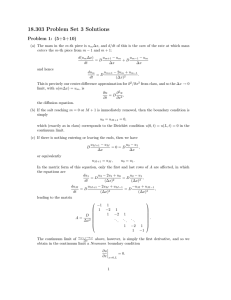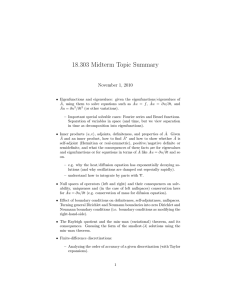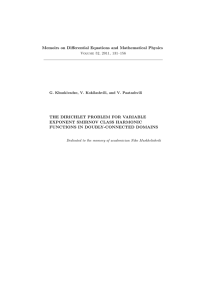18.303 Midterm, Fall 2011 Problem 1: (20 points)
advertisement
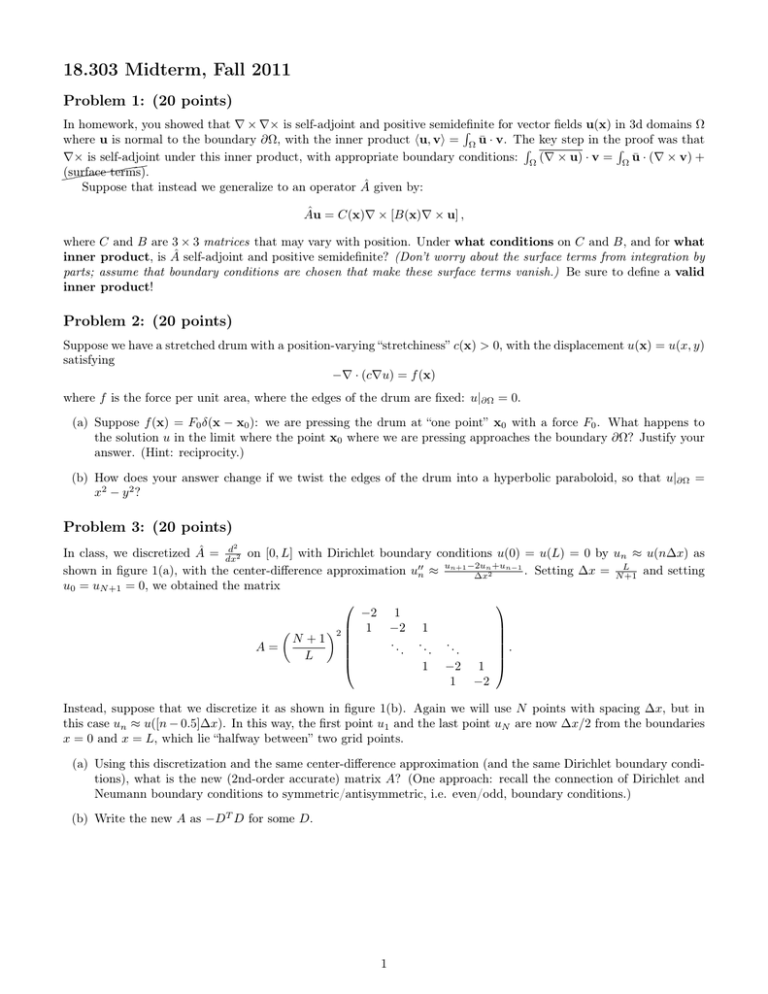
18.303 Midterm, Fall 2011 Problem 1: (20 points) In homework, you showed that ∇ × ∇× is self-adjoint and positive semidefinite for vector fields u(x) in 3d domains Ω R where u is normal to the boundary ∂Ω, with the inner product hu, vi = Ω ū · v. The key step in the proof was that R R ∇× is self-adjoint under this inner product, with appropriate boundary conditions: Ω (∇ × u) · v = Ω ū · (∇ × v) + ( ( ( (surface (((terms). ( Suppose that instead we generalize to an operator  given by: Âu = C(x)∇ × [B(x)∇ × u] , where C and B are 3 × 3 matrices that may vary with position. Under what conditions on C and B, and for what inner product, is  self-adjoint and positive semidefinite? (Don’t worry about the surface terms from integration by parts; assume that boundary conditions are chosen that make these surface terms vanish.) Be sure to define a valid inner product! Problem 2: (20 points) Suppose we have a stretched drum with a position-varying “stretchiness” c(x) > 0, with the displacement u(x) = u(x, y) satisfying −∇ · (c∇u) = f (x) where f is the force per unit area, where the edges of the drum are fixed: u|∂Ω = 0. (a) Suppose f (x) = F0 δ(x − x0 ): we are pressing the drum at “one point” x0 with a force F0 . What happens to the solution u in the limit where the point x0 where we are pressing approaches the boundary ∂Ω? Justify your answer. (Hint: reciprocity.) (b) How does your answer change if we twist the edges of the drum into a hyperbolic paraboloid, so that u|∂Ω = x2 − y 2 ? Problem 3: (20 points) 2 d In class, we discretized  = dx 2 on [0, L] with Dirichlet boundary conditions u(0) = u(L) = 0 by un ≈ u(n∆x) as n +un−1 shown in figure 1(a), with the center-difference approximation u00n ≈ un+1 −2u . Setting ∆x = NL+1 and setting ∆x2 u0 = uN +1 = 0, we obtained the matrix −2 1 2 1 −2 1 N +1 . . . .. .. .. A= . L 1 −2 1 1 −2 Instead, suppose that we discretize it as shown in figure 1(b). Again we will use N points with spacing ∆x, but in this case un ≈ u([n − 0.5]∆x). In this way, the first point u1 and the last point uN are now ∆x/2 from the boundaries x = 0 and x = L, which lie “halfway between” two grid points. (a) Using this discretization and the same center-difference approximation (and the same Dirichlet boundary conditions), what is the new (2nd-order accurate) matrix A? (One approach: recall the connection of Dirichlet and Neumann boundary conditions to symmetric/antisymmetric, i.e. even/odd, boundary conditions.) (b) Write the new A as −DT D for some D. 1 (a) 0 u1 u2 u3 x=0 uN 0 x=L x u1 u2 u3 (b) 0 uN L x x/2 L x/2 Figure 1: Two possible grids for discretizing [0, L] with Dirichlet boundary conditions via N points with spacing ∆x. (a) the grid from class, where the boundaries are “on grid points,” located “at” u0 and uN +1 . (b) the grid from problem 3, where the boundaries are “halfway between grid points,” located “at” u−0.5 and uN +0.5 . 2
